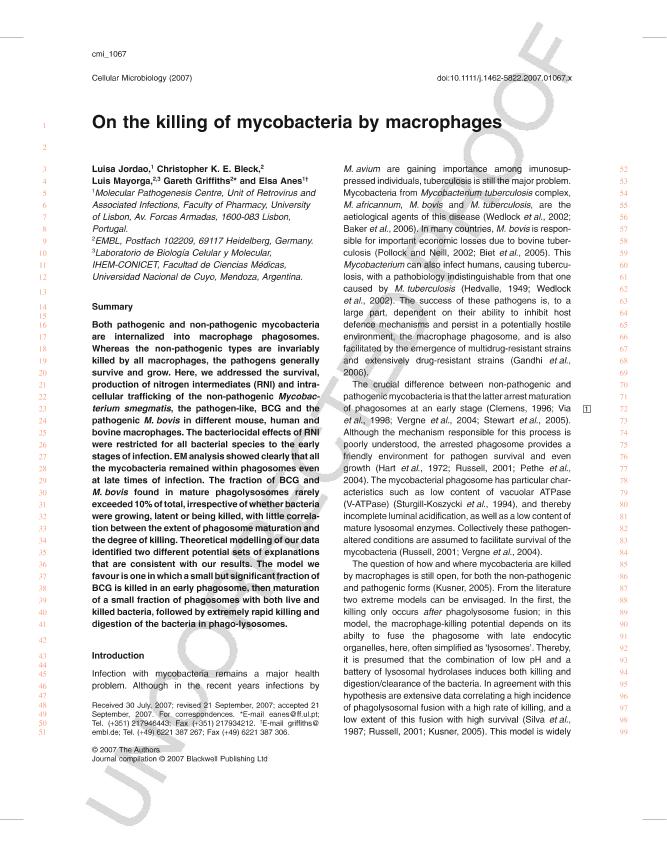Mostrar el registro sencillo del ítem
dc.contributor.author
Jordao, Luisa
dc.contributor.author
Bleck, Christopher K.
dc.contributor.author
Mayorga, Luis Segundo

dc.contributor.author
Griffiths, Gareth
dc.contributor.author
Anes, Elsa
dc.date.available
2021-03-04T20:33:07Z
dc.date.issued
2008-02
dc.identifier.citation
Jordao, Luisa; Bleck, Christopher K.; Mayorga, Luis Segundo; Griffiths, Gareth; Anes, Elsa; On the killing of mycobacteria by macrophages; Wiley Blackwell Publishing, Inc; Cellular Microbiology (print); 10; 2; 2-2008; 529-548
dc.identifier.issn
1462-5814
dc.identifier.uri
http://hdl.handle.net/11336/127532
dc.description.abstract
Both pathogenic and non-pathogenic mycobacteria are internalized into macrophagephagosomes. Whereas the non-pathogenic types are invariably killed by allmacrophages, the pathogens generally survive and grow. Here, we addressed thesurvival, production of nitrogen intermediates (RNI) and intracellular trafficking of thenon-pathogenic M. smegmatis, the pathogen-like, BCG and the pathogenic M. bovis indifferent mouse, human and bovine macrophages. The bacteriocidal effects of RNI wererestricted for all bacterial species to the early stages of infection. EM analysis showedclearly that all the mycobacteria remained within phagosomes even at late times ofinfection. The fraction of BCG and M. bovis found in mature phagolysosomes rarelyexceeded 10 % of total, irrespective of whether bacteria were growing, latent or beingkilled, with little correlation between the extent of phagosome maturation and thedegree of killing. Theoretical modelling of our data identified two different potentialsets of explanations that are consistent with our results. The model we favour is one inwhich a small but significant fraction of BCG is killed in an early phagosome, thenmaturation of a small fraction of phagosomes with both live and killed bacteria,followed by extremely rapid killing and digestion of the bacteria in phago-lysosomes.
dc.format
application/pdf
dc.language.iso
eng
dc.publisher
Wiley Blackwell Publishing, Inc

dc.rights
info:eu-repo/semantics/openAccess
dc.rights.uri
https://creativecommons.org/licenses/by-nc-sa/2.5/ar/
dc.subject
Mathematical model
dc.subject
Macrophage
dc.subject
Mycobacterium
dc.subject
Phagosome
dc.subject.classification
Biología Celular, Microbiología

dc.subject.classification
Ciencias Biológicas

dc.subject.classification
CIENCIAS NATURALES Y EXACTAS

dc.title
On the killing of mycobacteria by macrophages
dc.type
info:eu-repo/semantics/article
dc.type
info:ar-repo/semantics/artículo
dc.type
info:eu-repo/semantics/publishedVersion
dc.date.updated
2020-08-04T19:40:44Z
dc.journal.volume
10
dc.journal.number
2
dc.journal.pagination
529-548
dc.journal.pais
Reino Unido

dc.journal.ciudad
Londres
dc.description.fil
Fil: Jordao, Luisa. Universidad de Lisboa. Facultad de Farmacia; Portugal
dc.description.fil
Fil: Bleck, Christopher K.. European Molecular Biology Laboratory; Alemania
dc.description.fil
Fil: Mayorga, Luis Segundo. Consejo Nacional de Investigaciones Científicas y Técnicas. Centro Científico Tecnológico Conicet - Mendoza. Instituto de Histología y Embriología de Mendoza Dr. Mario H. Burgos. Universidad Nacional de Cuyo. Facultad de Ciencias Médicas. Instituto de Histología y Embriología de Mendoza Dr. Mario H. Burgos; Argentina. European Molecular Biology Laboratory; Alemania
dc.description.fil
Fil: Griffiths, Gareth. European Molecular Biology Laboratory; Alemania
dc.description.fil
Fil: Anes, Elsa. Universidad de Lisboa. Facultad de Farmacia; Portugal
dc.journal.title
Cellular Microbiology (print)

dc.relation.alternativeid
info:eu-repo/semantics/altIdentifier/url/https://onlinelibrary.wiley.com/toc/14625822/2008/10/2
dc.relation.alternativeid
info:eu-repo/semantics/altIdentifier/doi/http://dx.doi.org/10.1111/j.1462-5822.2007.01067.x
Archivos asociados
